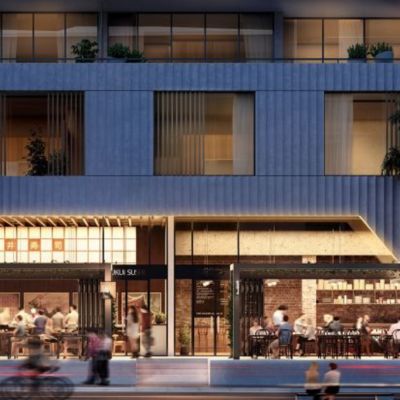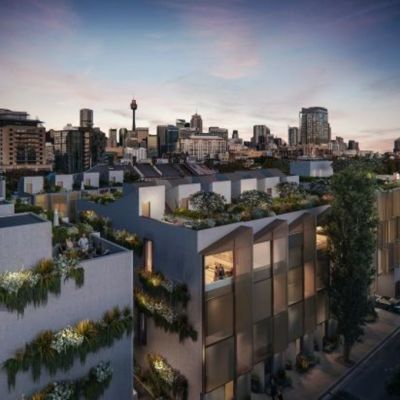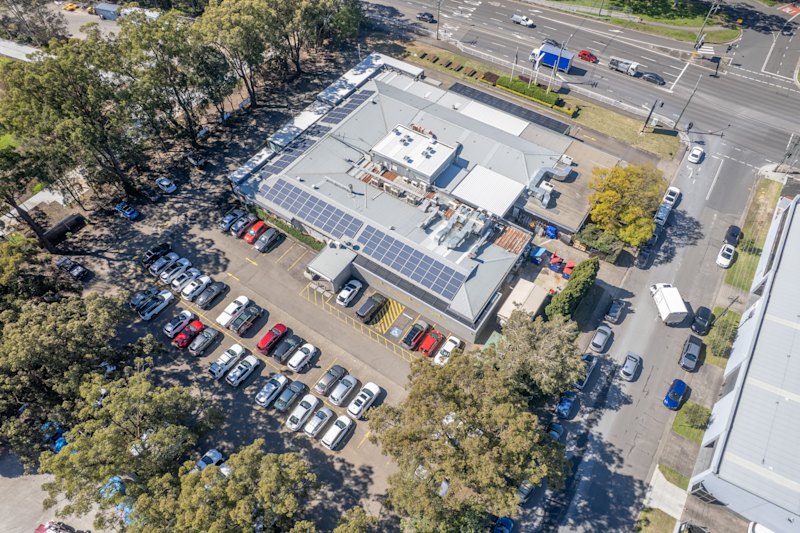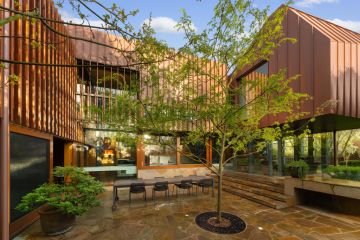Waterloo apartments inspired by jungle to splash out with seven-storey waterfall
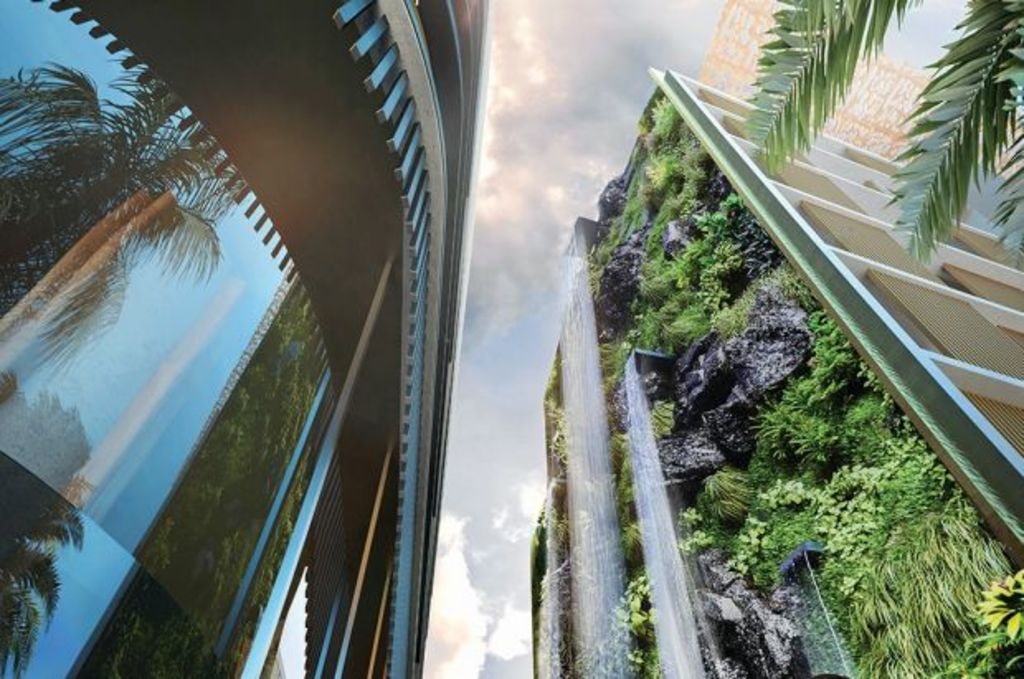
In a few years, a bamboo-covered walkway inspired by the jungles of Kalimantan will connect a new park in Waterloo with a trio of low-rise apartment blocks and a 20-storey tower.
Residents of the inner-city development will be able to stroll beneath the leafy canopy on their way to a tranquil lagoon, seek shelter under mature leatherwood trees or pass the time in a secluded outdoor retreat area.
And that noise? Oh, that’s just the sound of a waterfall – the largest man-made one in Australia – cascading seven storeys down the side of one of the buildings.
Crown Group chairman and group chief executive officer Iwan Sunito says Waterfall by Crown Group is inspired by the power of nature.
Designing the project brought back memories of his own childhood in Kalimantan, the Indonesian part of Borneo, where his family lived in a house overlooking a river, surrounded by jungle.
“Landscape has been fundamental to Crown Group’s developments and with this project we want to take that to the next level, bring nature back to the city,” Sunito says.
Sunito, an architect who co-founded the Sydney-based firm in the mid-1990s, says there has been surge in demand for homes that allow residents to escape the hustle and bustle of city life.
“We always define ourselves to be the most creative when we feel that we can relax, when we can feel the environment around us,” he says.
“When you’re slow, you’re fast because you’re not in a hurry or panicking and trying to get things done. We tap into the creativity within ourselves. In everyone’s heart, there’s always a yearning to go back to the wilderness.”
This desire among city-dwellers to make meaningful connections with nature – and the emergence of apartment projects that enable these connections – is part of a trend dubbed “wellness architecture”.
When health and wellness experts from around the world converged on the alpine town of Kitzbuhel, in Austria, for a Global Wellness Summit late last year, they identified eight trends for 2017.
Amid talk of designer saunas, adult colouring books and silent retreats, summit attendees predicted wellness architecture would be one of the most influential future trends.
“Architecture has been far too preoccupied with surface aesthetics: with architect-god-heroes conceiving designs to wow, shock or lay claim to the cutting-edge,” the summit paper states.
“Much ego, much beauty on the covers of Architectural Digest, but with oddly little attention paid to creating designs and using materials that improve the health and happiness of the humans who actually live and work in them.”
From air quality to designs that promote physical activity, commentators say wellness architecture has the potential to dramatically reshape the built environment.
There are already examples of “living” buildings with walls made of algae biofuel cells that grow their own energy. At Circular Quay, Sydney architecture practice Silvester Fuller has drawn up plans for an apartment building in AMP Capital’s Loftus Lane precinct with interior finishes, colours and layouts designed to promote wellness, including lighting and acoustics to encourage rest in the sleep zones.
American architect Veronica Shreibeis Smith, the founder and chair of the Global Wellness Institute’s Wellness Architecture Initiative, says the movement goes much deeper than incorporating sellable wellness strategies into new homes.
It requires considered use of non-toxic construction materials, for example, so that architecture is both regenerative and in harmony with humans and the local ecology.
Shreibeis Smith links the trend to the proliferation of social media postings of dream food, fitness and travel experiences. This “lifestyle inspo” drives people to look for ways to turn their dreams into reality.
For developers, the motivation comes down to three words: return on investment. “This means the smart developers are already investing in design centred around human health and wellbeing,” she says.
“Healthy buildings will have higher occupancy, sell at premiums, attract higher-yield buyers and increase in value over time.”
The $400-million Waterfall project comprises 331 residences in three seven-storey buildings and the high-rise tower, all designed by SJB. Inside, stone, timber and subtle hues combine to offer a fresh take on luxury living.
The luxurious natural vibe extends to the communal spaces, with ground-level water gardens, a recreation deck, infinity rooftop pool, sky garden and terrace, high-rise rooftop cinema and a gym featuring a glass-walled yoga room overlooking the lush landscaping.
Mika Utzon Popov, the grandson of Sydney Opera House architect Jorn Utzon, has been commissioned to create a large-scale artwork. There are plans for a music room, shops and cafes within the precinct, as well as the new public park next door.
Architect Adam Haddow, a director of SJB, says apartment developments in Sydney haven’t always made the most of the city’s temperate climate.
Motivated by scale of 1.2-hectare site and the area’s wetland past pre-white settlement, the design team drew up plans that put landscaping front and centre.
“It grew into the idea that we would take the garden up the building and onto the rooftops, at the same time elevating the pool out of the ground plane and into the sky plane,” Haddow says.
The tower building has a floor-plate shaped like a four-leafed clover, meaning all apartments occupy corner positions, while cross-ventilation, views and natural light are maximised.
The waterfall will soften the sounds of the city and create its own eco-system, making soft wind patterns that should take the edge off sweltering summer days.
Despite the spread of wellness architecture as an international trend, Haddow says there’s something distinctly Australian about the desire to seek out quiet spaces in big cities.
“I’ve just come back from Paris and Rome. Places like that are very hard, very active cities and I think Europeans are brought up that way,” he says.
“There isn’t that sense of quietness that most Australians are brought up with. And it’s not just going into that space – just looking at that place can make you feel calmer.”
Download the Domain app to search for new homes planned near you.
We recommend
We thought you might like
States
Capital Cities
Capital Cities - Rentals
Popular Areas
Allhomes
More
